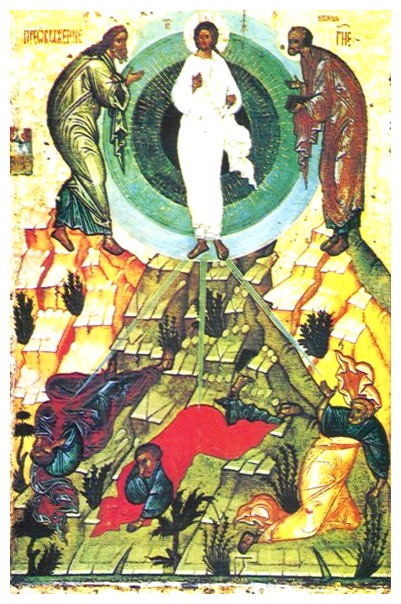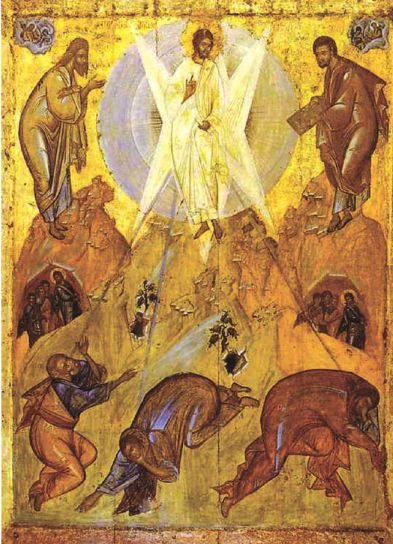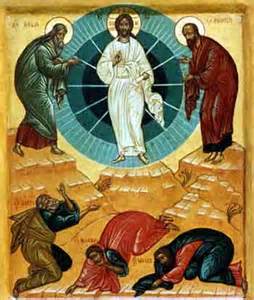LENT II - JOURNEY TO THE MOUNTAIN
TOP - THE TRANSFIGURATION
Last week our journey took us out in the wilderness of desert solitude, with its epi-centre, the time Jesus spent alone in the wilderness as a preparation for His ministry. This week we journey to another desolate and lonely place, a mountain peak. Anyone who has hiked in mountain ranges such as the Cascades or the Alps in Switzerland and Austria know that on a clear day the view from peaks are unforgettably clear and panoramic. Everything is sharper. We able to see features that perhaps we did not know existed before. In our reading for this Sunday the inner three saw events that hitherto had not been dreamt of by them. But was it sharper for them?
From a mountain top it is also so much easier to be conscious of the grandeur of God that “will flame out, like shining from shook foil; / It gathers to a greatness, like the ooze of oil/ Crushed.” Gerard Manley Hopkins also catches another glimpse of the Almighty at work as seen from a mountain.
Psalm 69. 36 “For God will save Zion, and build the cities of Judah: that men may dwell there, and will have it in possession.
Psalm 82. 1. “Her foundations are upon the holy hills: the Lord loves the gates of Zion more than all the dwelling of Jacob.
Psalm 102. 13 “Thou shall arise, and have mercy upon Zion: for it is time that you have mercy upon her, yea, the time is come.”
Psalm 12. 14 “For the Lord has chosen Zion to be an habitation for himself: he hath longed for her.
Psalm 137. “By the waters of Babylon we sat down and wept: when we remembered thee, O Zion. … Sing us one of he songs of Zion … How can we sing the Lord’s song: in a strange land?
Psalm 147. 12. “Praise the Lord, O Jerusalem: praise thy God, O Sion.”
When we ponder on these verses they reveal so many aspects of Israel’s history.
One aspect in the psalm and elsewhere in holy writ, we discover that mountains are often associated with the Lord, His presence and being closer to the celestial realm. In Ezekiel we read, “In the mountain of my holiness, in the mountain of the height of Israel, says the Lord Yahweh, there shall all the house of Israel serve me, that whole land” (Ez. 20. 40). Of course the priest-prophet had in mind the holy mount of Sinai where Moses and the chosen seventy experienced the holiness of God as and after He gave Moses the Commandments (Exodus 19:16-20:12).
*Moses, before he died saw the Promised Land from Mt. Pisgah in the Nebo range that is near the Dead Sea. He was forbidden to enter by Yahweh through his disobedience when he struck the rock for water rather than speak to it (Numbers 20. 8 -12).
*Aaron died at Mt Hor.
*Jacob‘s experience at Bethel was in the mountains of Ephraim where he built his altar after his dream of angels descending and ascending (Gen 35. 1- 15).
*Laban and Jacob met at Mt. Gilead.
*Barak’s camp was at Mt. Tabor.
*Saul and Jonathon met death at Mt. Bilboa.
When we turn to Gospel time, Jesus would have been very familiar with mountain peaks. From His home in Nazareth He would have climbed the hills often, presumably many times to be with His Father. From there He would not have had any trouble of seeing the snow capped Mt. Hermon in the northern most part of Galilee, the source of the Jordan. It is 20 miles from the Sea of Galilee. To the south of Nazareth is Mt. Tabor, 14 miles east of Nazareth, at the north-east corner of the Yizrael (Jezreel) Valley. From here is a magnificent view.
Let’s now turn to the reading for this Sunday, the Second of Lent, the Transfiguration. Whether the Transfiguration took place on Mt Tabor or Mt. Hermon, our Lord would have known both well. It is a taste of heaven in the Synoptic Gospel accounts (Matt. 17:1-6, Mark 9:1-8, Luke 9:28-36 and the Gospel of the Holy Twelve; Lection 46).
1. AFTER six days, when the Feast of Tabernacles was nigh at hand, Iesus taketh the twelve and bringeth them up into a high mountain apart, and as he was praying the fashion of his countenance was changed, and he was transfigured before them, and his face did shine as the sun, and his raiment was white as the light.
2. And, behold, there appeared unto them Moses and Elias talking with him and spake of the Law, and of his decease which he should accomplish at Jerusalem.
3.. And Moses spake, saying, This is he of whom I foretold, saying, A prophet from the midst of thy brethren, like unto me shall the Eternal send unto you, and that which the Eternal speaketh unto him, shall he speak unto you, and unto him shall ye hearken, and whoso will not obey shall bring upon themselves their own destruction.
4. Then Peter said unto Iesus, Lord, it is good for us to be here; if thou wilt let us make here three tabernacles; one for thee, and one for Moses, and one for Elias.
5. While he yet spake, behold a bright cloud overshadowed them, and twelve rays as of the sun issued from behind the cloud, and a voice came out of the cloud, which said, This is my beloved Son, in whom I am well pleased; hear ye him.
6. And when the disciples heard it, they fell on their faces and were sore amazed, and Jesus came and touched them and said, Arise and be not afraid. And when they had lifted up their eyes, they saw no man, save Jesus only. And the six glories were seen upon him.
7. AND Iesus said unto them, Behold a new law I give unto you, which is not new but old. Even as Moses gave the Ten Commandments to Israel after the flesh, so also I give unto you the Twelve for the Kingdom of Israel after the Spirit.
8. For who are the Israel of God? Even they of every nation and tribe who work righteousness, love mercy and keep my commandments, these are the true Israel of God. And standing upon his feet, Jesus spake, saying:
9. Hear O Israel, JOVA, thy God is One; many are My seers, and My prophets. In Me all live and move, and have subsistence.
10. Ye shall not take away the life of any creature for your pleasure, nor for your profit. nor yet torment it.
11. Ye shall not steal the goods of any, nor gather lands and riches to yourselves, beyond your need or use.
12. Ye shall not eat the flesh, nor drink the blood of any slaughtered creature, nor yet any thing which bringeth disorder to your health or senses.
13. Ye shall not make impure marriages, where love and health are not, nor yet corrupt yourselves, or any creature made pure by the Holy.
14. Ye shall not bear false witness against any, nor wilfully deceive any by a lie to hurt them.
15. Ye shall not do unto others, as ye would not that others should do unto you.
16. Ye shall worship One Eternal, the Father-Mother in Heaven, of Whom are all things, and reverence the holy Name.
17. Ye shall revere your fathers and your mothers on earth, whose care is for you, and all the Teachers of Righteousness.
18. Ye shall cherish and protect the weak, and those who are oppressed, and all creatures that suffer wrong.
19. Ye shall work with your hands the things that are good and seemly; so shalt ye eat the fruits of the earth, and live long in the land.
20. Ye shall purify yourselves daily and rest the Seventh Day from labour, keeping holy the Sabbaths and the Festival of your God.
21. Ye shall do unto others as ye would that others should do unto you.
22. And when the disciples heard these words, they smote upon their breasts, saying: Wherein we have offended. O God forgive us: and may thy wisdom, love and truth within us incline our hearts to love and keen this Holy Law.
23. And Jesus said unto them, My yoke is equal and my burden light, if ye will to bear it, to you it will be easy. Lay no other burden on those that enter into the kingdom, but only these necessary things.
24. This is the new Law unto the Israel of God, and the Law is within, for it is the Law of Love, and it is not new but old. Take heed that ye add nothing to this law, neither take anything from it. Verily I say unto you, they who believe and obey this law shall be saved, and they who know and obey it not, shall be lost.
25. But as in Adam all die so in Christ shall all be made alive. And the disobedient shall be purged through many fires; and they who persist shall descend and shall perish eternally.
26. And as they came down from the mountain, Jesus charged them, saying, Tell the vision to no man, until the Son of man be risen again from the dead.
27. His disciples asked him, saying, Why then say the scribes that Elias must first come? And Jesus answered and said unto them, Elias truly shall first come and restore all things.
28. But I say unto you, that Elias is come already, and they knew him not, but have done unto him whatsoever they listed. Likewise shall also the Son of man suffer of them. Then the disciples understood that he spake unto them of John the Baptist.
LECTION 46. 2-7. - The appearance of Moses, to hand over, as it were, the Law and the Dispensation to Jesus, throws a light on the reason of the Transfiguration, which is lost in the accepted version. Elias also appears, so as to make, with Moses, the "two witnesses" required by the law. They recognize Jesus, and witness to him as the great Prophet whom God should raise to succeed and take the place of Moses as the Legislator of the New Dispensation.
The "six glories" of Christ may refer to the six precepts.
LECTION 46. 10-12 - Compare this with the Law as given by Moses. In the law given by Christ there are six negative and six positive. The negative is the external Way, in which certain actions are forbidden. The positive, the interior way, in which certain duties are enjoined. As the prohibitions are summed up in the negative form of the Golden Rule, so the commands are summed up in the positive form. Had this law been faithfully observed by all Christians, there would have been no divisions or war as now, and this earth would have been a paradise for all.
v. 12. -" Slaughtered "is the truer rendering which has in former editions been wrongly translated "living."
LECTION 46. 24.-The law as given through Moses "by the ministry of angels," and as the Church of Israel (the typical nation) received it through their Interpreters and Scribes, had no precept forbidding cruelty, oppression, flesh eating, drunkenness, the worship of mammon, impure marriages for money or position, and other vices and crimes which are the cause of nearly all the misery which now afflicts men and women " called to be happy sons and daughters of God Almighty , and which are visited by the holy Law on the children to the third and fourth generation of them that despise it, shewing mercy to all who love it." Nor yet did it include that mutual consideration for each other (positively and negatively) which is summed up in the one commandment of Christ "Love ye one another," not excluding there from the creatures which God hath given to be our earth mates and companions.
So let’s read and ponder on Luke 9. 28 – 36.
The Transfiguration on the Mount according to Luke. According to tradition this took place on Mt. Tabor. Indeed in the Orthodox tradition it is referred to as the feast of Mt. Tabor. Many scholars see this event as a post-resurrectional experience rather than one anticipating the passion of Christ.
In theological terms this is known as a theophany, meaning a manifestation of God. This dazzling brightness emanated from his entire body and was produced by an interior reflection of holy Divinity. "His face did shine as the sun and his garments became white as snow."
OUR JOURNEY TO THE MOUNT
Although the theophany on Mt Tabor or Mt. Hermon is probably a post-resurrectional account, its position in the Synoptics is teaching us another message. It comes before the passion and death of Christ and the immediate healing of the epileptic. So what is its message to us for our Lenten journey? On the mount our Lord is revealed in all His glory. We must taste of that glory before we descend to the plain. To do that we have to ascend the mountain. Anyone who has climbed peaks knows that is no easy task, even if we are fit. Like Christian in “Pilgrim’s Progress” we shall stumble over rocks and ravines in the climb many times and sometimes fall back a few feet before we approach the peak. As Christians we know that praying and fasting and almsgiving help us to scramble over those rocks. That ascent should enable us to see our lives in relation to that of the Lord. Once reaching the peak let us too find a quiet spot to pray and to examine our lives.
and made human nature, darkened in Adam,
once again shine forth,
changing it into the glory and radiance
of your own divine nature.
Christ’s transfiguration can cause light to shine in our souls and show us what our destiny is. Don’t forget that the Lord Jesus came amongst us human beings to change us all into glorious children so that we too can shine brightly. We too can be the beloved children of the Father. Don’t forget too that the events of the holy mount give us all a taste of heaven.
Marianne Dorman
Return to Index
To Lent III


